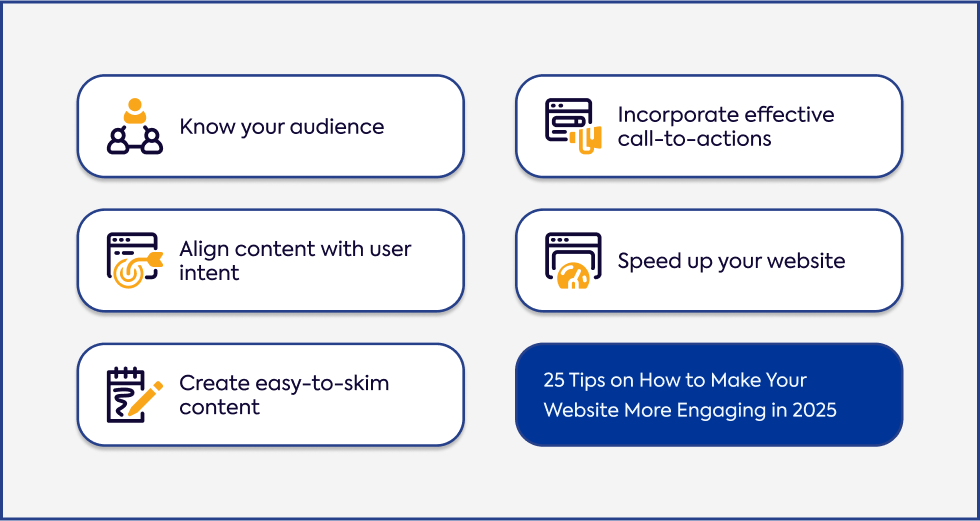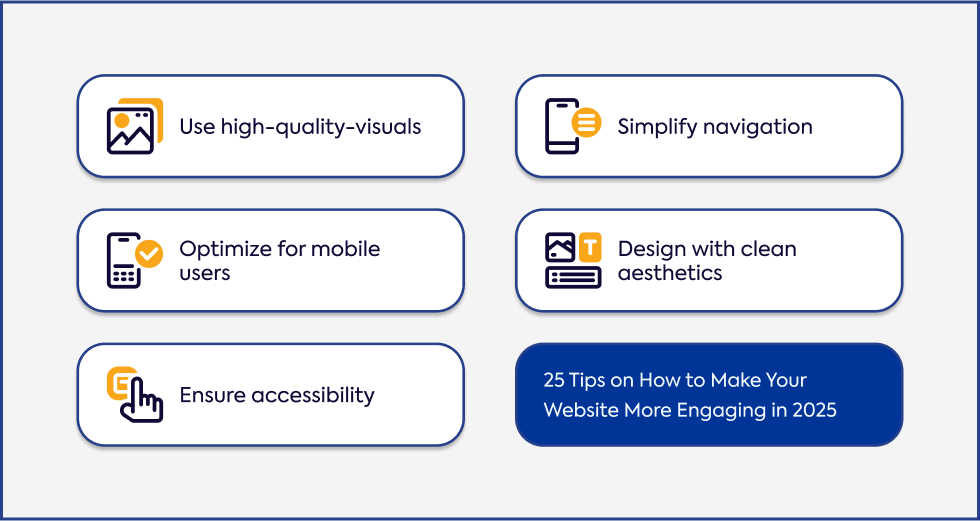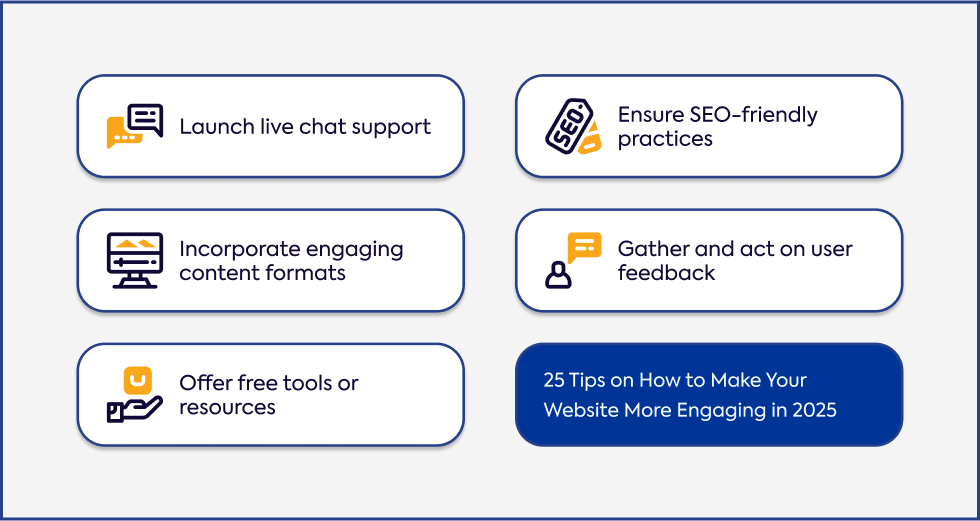Key Takeaways
- Knowing your audience and aligning content with their needs is fundamental for building a good website.
- Ensure your website is easy to navigate with clear calls to action (CTAs) and a clean, user-friendly design.
- Use your website to display high-quality visuals, personalize user experiences, and offer interactive content like quizzes or videos to engage visitors.
- Optimize your website for mobile users, speed, and accessibility, improving user retention and overall satisfaction.
- Regularly test your website and gather user feedback to refine and improve different elements, keeping it engaging for both new users and returning visitors.
Why an Engaging Website is Important for Success
Having an engaging website is a key part of growing your business online.
When you create an engaging website, you offer a professional platform for online transactions, making it easier for customers to interact with your business.
It also strengthens your reputation by providing informative content, like blogs, to position your company as an expert in your field.
Your website can serve as a hub for company updates, product launches, and services.
It’s also a powerful tool for collecting customer information through email newsletters, helping you stay connected with your audience.
Integrating ads and social media into your website design further boosts your brand’s visibility.
A well-designed website improves your website credibility by displaying trust signals like privacy policies, testimonials, and awards.
By addressing these elements, you can reduce bounce rates, driving users to engage with your content and move through the sales funnel.
An engaging website encourages long-term interaction with clear call to action, which helps boost conversion rates.
It also enhances SEO, making it easier for users to find you through search engines.
Easy Tips on How to Make Your Website More Engaging

1. Know Your Audience
Understanding your audience is the foundation of good web design.
To create an effective website, you need to know who your target audience is.
By researching their demographics, behaviors, and preferences, you’ll be able to shape your site’s design, messaging, and overall experience.
This approach will not only increase user engagement but also ensure that your website speaks directly to the needs of different customer segments.
Whether you’re running an online business or offering services, knowing your audience helps you make informed design choices and tailor your content effectively.
2. Align Content with User Intent
To make your website valuable to visitors, you should ensure your content aligns with their needs at every stage of their journey.
Dedicated specific pages that match different phases—whether it’s research, consideration, or purchase—keep users engaged.
Using relevant content, like blog posts, helps attract and maintain their attention.
Additionally, understanding what users are searching for allows you to optimize pages and direct them through internal links, guiding them toward what they need.
3. Create Easy-to-Skim Content
Ensuring your content is easy to read is key for user retention.
Visitors are more likely to stay on your site if they can quickly digest the information.
This is where visually appealing layouts, white space, and structured headings make a difference.
Breaking up text with bullet points, short paragraphs, and visuals improves the flow and makes reading easier.
When creating an engaging site, it’s important to focus on readability and design simplicity.
4. Incorporate Effective Call-to-Actions (CTAs)
Clear CTAs are essential for guiding users through the site.
Place them in strategic locations to encourage interaction and help users take the action that you want them to.
Personalized CTAs - based on user behavior - will have a higher impact.
For example, you can encourage users to subscribe to the newsletter or interact with a video, depending on where they are in their journey.
Visual prominence, like contrasting colors, helps CTAs stand out.
5. Speed Up Your Website
No one likes waiting for a slow website to load.
You need to optimize your website for speed to keep users from leaving before they’ve had a chance to explore your content.
Using tools like Google’s PageSpeed Insights, you can analyze your site and find areas for improvement.
Faster load times, especially on mobile devices, can significantly enhance the user experience, while also boosting your site’s search ranking.

6. Use High-Quality Visuals
High-quality visual elements play a big role in creating an appealing website.
Incorporating video content, infographics, and photos can make your site feel more engaging and dynamic.
Free tools like Canva can help you create visual elements that look professional without slowing down your site.
Videos, in particular, tend to boost interaction rates, making them a great addition to pages like your homepage or product pages.
7. Optimize for Mobile Users
Since more people are accessing websites on their phones, optimizing for mobile devices is a must.
A responsive design ensures that your site looks and functions well on any screen size.
Avoid disruptive pop-ups and make sure your layout is mobile-friendly.
Fast-loading mobile pages are essential, as users are less likely to stay on a site that loads slowly on their phones.
8. Ensure Accessibility
Making sure everyone can use your site means thinking about accessibility features.
Simple things like including your contact details in easy-to-find places, offering transcripts for videos, and adding captions for hearing-impaired users can make your site more inclusive.
You’ll also want to consider implementing alt text for images to assist users relying on screen readers.
9. Simplify Navigation
A well-organized navigation menu helps visitors quickly find what they’re looking for.
Ensure that all important pages are accessible through easy-to-use menus, and include relevant links throughout your site.
Users should be able to easily find their way around without getting frustrated.
A search function can be a helpful addition, allowing users to locate specific content effortlessly.
10. Design with Clean Aesthetics
When designing your site, it’s essential to use a clean design that isn’t overcrowded with unnecessary details.
The effective use of white space can make your content easier to digest and improve focus on key sections.
Stick to a minimal color scheme and avoid clutter to create a beautiful website with a professional feel.
Organizing content in well-defined sections also enhances readability.

11. Select Appropriate Colors
Choosing the right color palette for your website can make all the difference.
You should limit your colors to a maximum of three, with one acting as an accent.
Choosing the right color palette involves thinking about how your colors reflect your brand identity and how they affect the user's emotions.
Colors like blue can convey trust, while red can create urgency.
Make sure your CTAs use contrast colors to stand out and attract attention.
12. Maintain Consistent Branding
Consistency is important across your website.
Your branding consistency should extend from your online business to the website itself, with unified colors, fonts, and logos.
This creates a cohesive experience that strengthens your brand identity.
Ensure all your relevant content aligns with your company’s mission and tone, keeping branding uniform across specific pages and sections.
13. Personalize the User Experience
Today’s users expect personalization.
You can use audience research to engage with your audience by tailoring content and visuals to different segments.
Ensure that the user experience feels customized based on preferences and past interactions.
Offering interactive elements like chatbots, and the option to subscribe to your newsletter, makes the experience more personal and engaging.
14. Display Social Proof
Social media platforms can be integrated into your website to highlight your credibility.
Featuring social proof like customer reviews and success stories builds trust with potential clients.
Make it a habit to display company logos, case studies, and highlight customer stories to strengthen your brand’s credibility and foster trust with new visitors.
15. Integrate Interactive Features
Interactive features are a great way to make your website more engaging and keep users involved.
Use tools like live chat to offer immediate customer support, or interactive tools like quizzes and calculators to engage your audience.
Adding live chat support can help visitors get quick answers, enhancing their overall experience.

16. Use Video Content
Incorporating video content into your site is one of the most effective ways to boost engagement.
Users tend to interact more with videos than with text, making them a great way to communicate complex ideas or demonstrate products.
Videos also encourage users to stay on your site longer and increase social media sharing.
Make sure to add captions for accessibility and optimize videos for quick loading times.
17. Improve Form Usability
If your website includes forms, focus on form usability.
Keep them simple and reduce the number of required fields.
Clear instructions and error messages make the process smoother for users, and offering the use of autofill can make form completion faster and more convenient.
Always place forms in visible areas, such as landing pages or the contact section.
18. Continuously Test and Optimize
To keep your site running efficiently, you’ll need to optimize your website continually.
Conduct regular A/B testing to see which elements work best, and track KPIs like bounce rates and conversion rates.
Use feedback from tools like Google Analytics and Hotjar to spot trends and improve your website based on real user behavior.
Keep everything up to date, from content to CTAs, to ensure your site reflects current trends.
19. Add Internal Links Strategically
Using internal links wisely helps users find relevant content and keeps them engaged longer.
When you include relevant links in your pages, you also distribute page authority, which can boost your SEO rankings.
Place these links in key locations like blog posts and product pages, but don’t overdo it—focus on quality and relevance.
Regularly check that all links are functional.
20. Use Social Media Plugins
Adding social media plugins to your site makes it easy for users to share your content on platforms like Facebook and Twitter.
This can drive inbound traffic and increase your brand’s visibility.
Make sure these plugins are easy to find, such as in the header or footer, and ensure they are functional on all devices.
Social media engagement metrics, like follower counts, can also be displayed to further boost credibility.

21. Launch Live Chat Support
Implementing live chat is an excellent way to offer real-time assistance to your website visitors.
You can use AI-powered chatbots to handle simple queries while keeping human agents available for more complex concerns.
Real-time support not only improves customer satisfaction but can also lead to higher conversion rates.
Analyzing chat data can provide valuable insights into what your customers need.
22. Incorporate Engaging Content Formats
Offering varied content formats is a smart way to engage different types of users.
Adding multimedia content, including videos, images, and infographics, keeps things interesting.
Skimmable text with headers and bullet points helps users quickly find the information they need.
Interactive content formats like quizzes or tools can make your website even more engaging.
23. Offer Free Tools or Resources
Offering free tools like calculators or guides can attract visitors and keep them engaged.
Provide educational tools or downloadable PDFs to solve user problems without requiring immediate sign-up.
This strategy builds trust and encourages users to explore more of your site.
When done right, these practical resources can lead to more sign-ups and conversions.
24. Ensure SEO-Friendly Practices
To rank higher on search engines, you need to focus on search engine optimization (SEO).
This involves performing keyword analysis to ensure your content matches what users are searching for.
Create optimized page titles, use meta tags, and ensure your site is easy to navigate with internal links.
Regular SEO audits help you identify and fix any technical issues that could affect your rankings.
25. Gather and Act on User Feedback
Finally, gathering user feedback is essential for ongoing improvement.
Use heatmap tools and analyze user behavior to see how visitors interact with your site.
Conduct customer surveys to gather insights and identify any pain points users experience.
Acting on this feedback helps you make informed decisions and improve the user experience over time.
Is Your Website as Engaging as It Could Be?
Your website is the core of your digital presence, and keeping users engaged is essential for business growth.
If you're facing challenges with user engagement or unsure how to optimize your site, Gauss is here to offer the solution.
We specialize in creating custom web experiences that captivate users and drive results, from seamless design to powerful functionality.
Ready to elevate your website? Let’s discuss how we can bring your ideas to life.
Contact Gauss today to start a conversation about building a website that truly connects with your audience!
